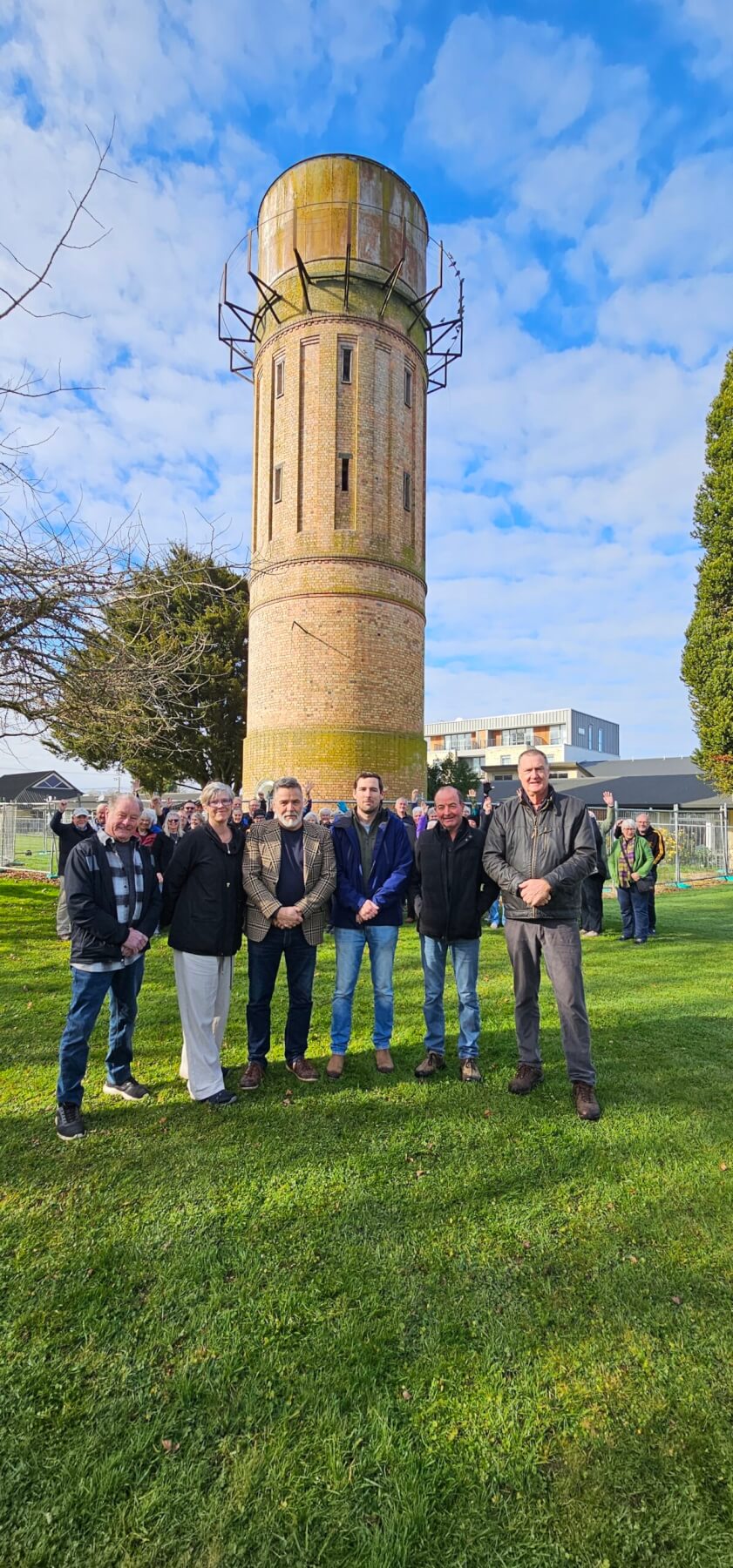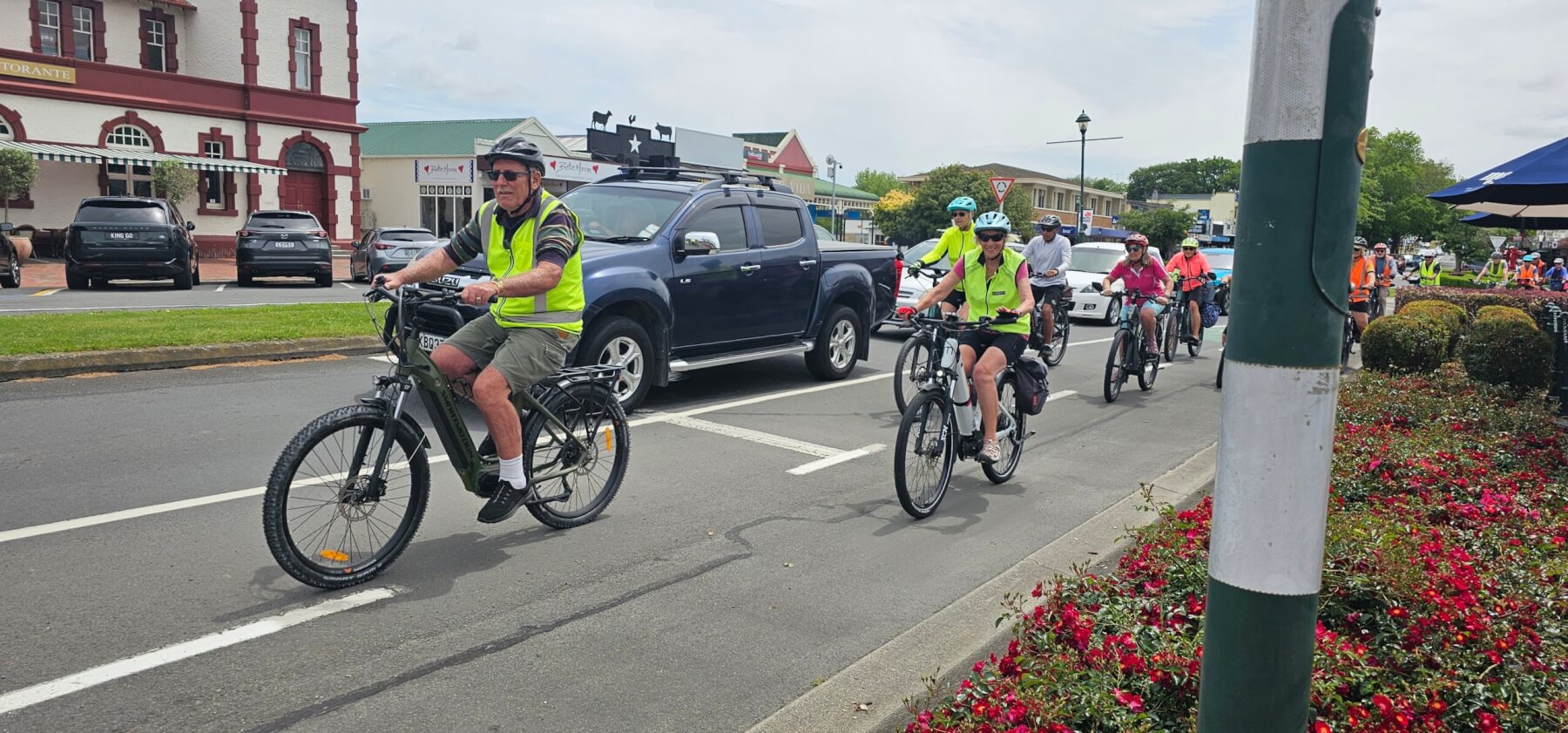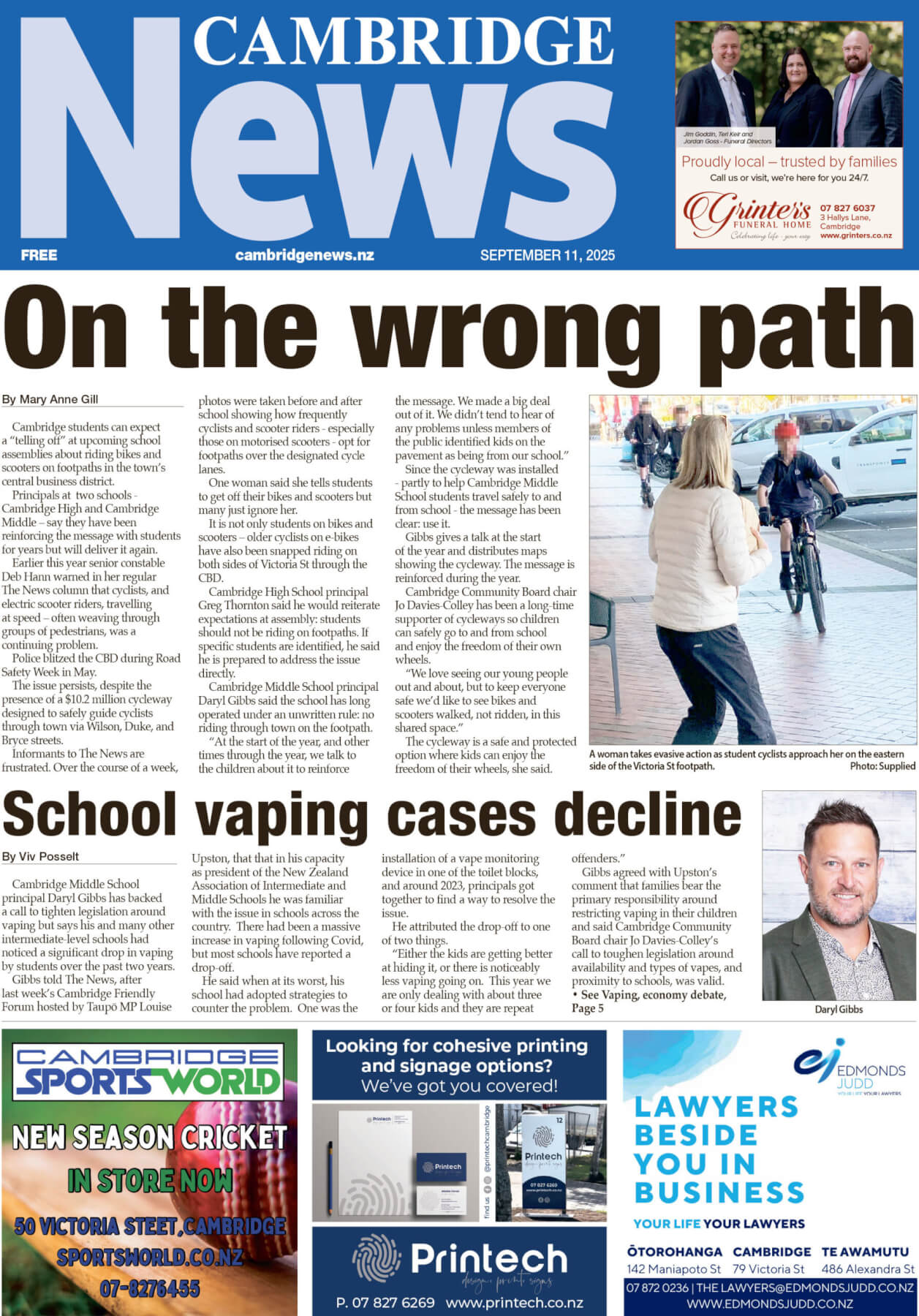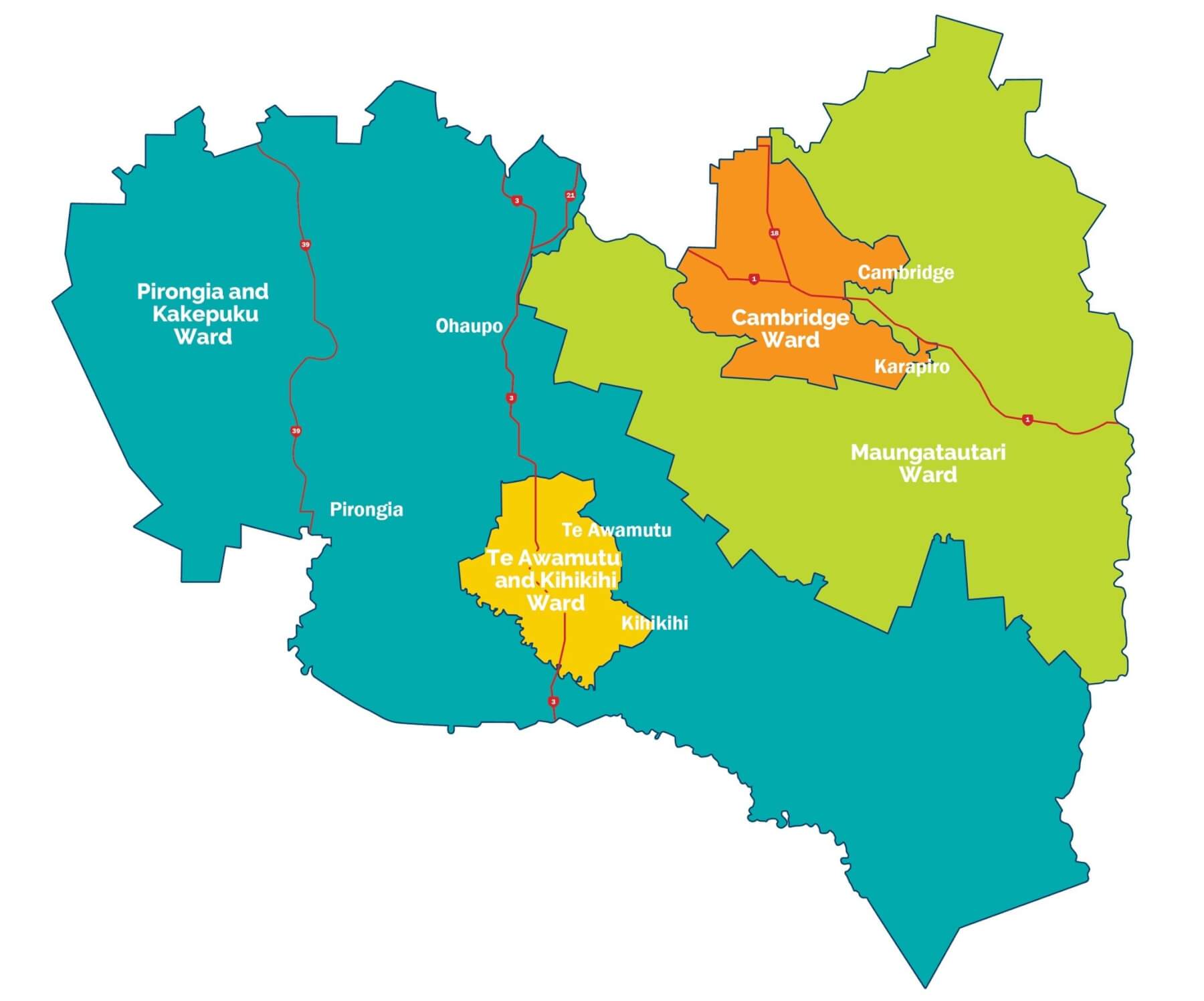
Letters to the Editor
Another tower view

Save the Cambridge Water Tower group founders, from left, Dave Linthwaite, Elizabeth Harvey, Peter Fulton, David Griffin, James Casey, Mike Kilgour. Photo: Mary Anne Gill.
Peter Fulton of the Cambridge Water Tower Group puts forward his group’s case for retention of the water tower. Reading between the lines it seems that despite his claim that the tower’s future is still uncertain I submit it is almost certain that it will be retained at great expense to already overburdened ratepayers with a commensurate impact on rates.
There can be no justification for keeping what is just a pile of bricks with no architectural merit. The fact the tower was built in 1903 does not of itself make it worthy of retention. It has served no useful purpose since 1926 when it should have been demolished for next to nothing. Retaining the tower at vast expense when we in Leamington have to carry a torch at night to be able to see our way because of inadequate or broken street lighting, have to put up with blocked drains, weeds and detritus in gutters, broken footpaths that are a health and safety hazard especially at night given the inadequate/broken lighting and more is obscene.
I challenge Mr Fulton and his group to put their money where their enthusiasm is and either pay for the cost of retention works and ongoing maintenance themselves or embark on a fund raising campaign to pay for what they want thereby allowing the deficiencies in service provision in Leamington, for example, to be paid for by our rates. This would be a good opportunity for his group to establish themselves as the Water Tower Trust who would take ownership of, manage, and pay for the tower going forward. I and many who share my views who I have spoken to would not object to council kick starting their work by a grant of, say $50,000.
Kelvin Dunn
Leamington
Bikes and paths

Cyclists in Cambridge
I see that after all the money spent on cycleways there is still a problem with cyclists on the footpath. I wonder if any of the councillors have actually cycled up and down Victoria Street in the centre of town. I would not be so brave, what with cars entering and reversing from the parking spaces, many doing it blind, as having to reverse out without a clear view. No wonder cyclists prefer the footpath.
There are two simple solutions that only require paint. One – make the cycle lane beside the footpath, moving the parking spaces out the required width, or, two – make the cycle lane next to the centre island, which would require a crossing at either end of the main street, but still safer than the footpath.
Maybe the footpaths are wide enough to include a cycle-lane. Public safety should prevail, rather than wishful thinking.
Delwyn Smith
Cambridge
See: On the wrong path
Scooters and rules

Cambridge News 11 September 2025
In response to ‘On the Wrong Path’ (The News, September 11), while I understand the concerns raised, the article overlooks several key points about e-scooter rules and the challenges faced by riders, especially young people.
My own child, who regularly rides an e-scooter to and from school, has been verbally abused and threatened multiple times, both on the road and footpath. These negative encounters stem from many of the public not fully understanding the rules around e-scooter use, particularly when it comes to designated cycle lanes. After an alarming incident where my child was cut off by a car in the CBD cycle lane, causing a crash with the vehicle, I researched the rules and advised him to stick to the footpath in town to reduce the risk of further accidents.
To clarify, current New Zealand regulations state that e-scooters can be ridden on the footpath or the road, but not in designated cycle lanes that are specifically intended for cyclists. On the footpath, e-scooter riders are required to drive carefully and considerately, ride at a speed that doesn’t put other footpath users at risk and to give way to pedestrians and mobility device users.
It is worth noting that e-scooters are now available for hire in more than 15 locations across New Zealand, including Dunedin, Bay of Plenty, Palmerston North, Christchurch, Hamilton, Wellington, Auckland and Hutt Valley with the list growing. These e-scooters can be ridden both on roads and footpaths, and they are increasingly becoming a popular and sustainable transport option for a wide range of people. In fact, Chris Rodley from NZTA has highlighted that “e-scooters have made, and continue to make, a useful contribution to the land transport system” and that their use is not only growing, but also contributing to emissions reductions and improving overall user satisfaction.
Nadia Dixon
Cambridge
Māori Wards

Waipā District Council comprises a mayor (elected at large) and 11 councillors, elected from five wards: Pirongia-Kakepuku General Ward (2 councillors), Cambridge General Ward (4 councillors), Maungatautari General Ward (1 councillor), Te Awamutu-Kihikihi General Ward (3 councillors), Waipā Māori Ward (1 councillor).
I read Maria Low’s letter (The News August 21), and the last paragraph made me stop and think. I quote Maria ‘the Māori Ward is a small step towards a council that truly represents all Waipā. Instead of asking why Māori should have a place at the table, maybe the real question is why shouldn’t we want that voice included?’ Absolutely.
In 2021 Waipā District Council consulted with the community regarding the introduction of a Māori ward councillor. Of the 900 submissions, 84 per cent were in favour. It is therefore disappointing that we are now being asked to revisit this decision with a referendum. It is an unnecessary expense for a council already struggling with debt.
Māori ward councillors, once elected, serve the whole community, just as rural ward councillors do. In fact, three rural ward councillors represent a similar portion of rate payers as our one Māori ward councillor.
Retaining this ward strengthens our relationship with local iwi. The Māori economy is growing rapidly and there are opportunities for council and iwi to partner on projects that bring economic, heritage and ecological opportunities to our community.
As a tour manager I frequently work with iwi to provide cultural experiences for both domestic and international visitors. It is always inspiring to watch people connect with a world that has always been around them but is often unseen. Let’s be collaborative, inclusive and forward thinking and vote yes for a Māori ward.
Penny Pickett
Leamington

Letters to Editor. Photo: Pixabay








